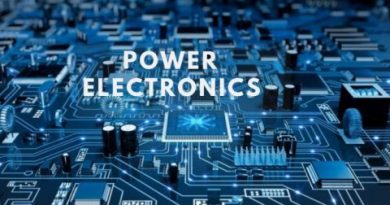What is Power Electronics? Types, Fields, Applications
What is Power Electronics, Types, Fields, Applications
Table of Contents
Introduction to Power Electronics
Major Applications of Power Electronics
- AC/DC Conversion
- DC/AC Conversion
- DC/DC Conversion
- AC/AC Conversion
Power Electronic Devices and Components
- Diodes
- Transistors
- Thyristors
- Gate Turn-Off Thyristors (GTO)
- Insulated Gate Bipolar Transistors (IGBT)
- MOSFETs
- Other Emerging Devices
Power Electronic Converters and Circuits
- AC to DC Converters
- DC to DC Converters
- DC to AC Converters
- AC to AC Converters
- Switching Power Supplies
- Inverters
- Battery Charging Systems
Control of Power Electronic Systems
- Quantifying Control Objectives
- Designing Control Loops
- Implementing Control Algorithms
- Generating Switching Signals
- Analog vs. Digital Control
- Feedback vs. Feedforward Control
Design and Modeling Considerations
- Load and Source Characteristics
- Device Ratings and Specifications
- Thermal Management
- Protection and Redundancy
- EMI and harmonics Mitigation
- Reliability and Lifetime
Advantages of Power Electronics
- High Efficiency
- Flexible Control
- Compact Size
- Reliable Operation
- Fast Response
- Precise Regulation
Applications of Power Electronics
- Renewable Energy Systems
- Electric Vehicle Systems
- Traction and Transportation
- Industrial Motor Drives
- Power Supplies
- HVDC Transmission Systems
- Smart Grid Technologies
The Future of Power Electronics
- New Materials and Devices
- Advanced Topologies and Control
- Increased Power Density
- Higher Frequencies and Bandwidths
- Greater Reliability and Lifetime
- Expanded Applications
Conclusion
What is Power Electronics, Types, Fields, Applications
Introduction to Power Electronics
Power electronics refers to the specialized field of electrical engineering focused on controlling and converting electric power using advanced electronic components and switching devices. Power electronics provide the critical interface between electrical sources like batteries, generators, or utility grids and electrical loads like motors, heating coils, or consumer electronics, enabling precise regulation and power flow optimization. By incorporating power semiconductor devices like diodes, transistors, and thyristors into specialized converter circuits and precisely controlling their switching, power electronics allow conversion and control capabilities far superior to traditional electromechanical and linear solutions. This enables higher efficiency, reliability, flexibility, and performance across various applications.
Major Applications of Power Electronics
Some major application areas that rely critically on power electronics include:
AC/DC Conversion
It is also called rectification, converting AC power to DC for electronic devices and battery charging.
DC/AC Conversion
Also called inversion, converting DC into standardized AC to interface with the utility grid.
DC/DC Conversion
Converting between DC voltage levels for charging batteries, powering devices, or interfacing energy sources.
AC/AC Conversion
Changing the voltage, frequency, or other parameters of AC power for specialized loads or grid support.
Power Electronic Devices and Components
Power electronics uses specialized power semiconductor switches tailored to handle high voltages and currents efficiently:
Diodes
The simplest semiconductor devices are used for rectification and protection.
Transistors
Bipolar junction transistors switch and amplify signals in many power electronic circuits.
Thyristors
SCRs and TRIACs provide switching and rectification in AC power control applications.
Gate Turn-Off Thyristors (GTO)
Allow control over turn-on and turn-off capabilities, unlike SCRs.
Insulated Gate Bipolar Transistors (IGBT)
Combine BJT’s current handling with MOSFET switching capabilities.
MOSFETs
Used extensively for their fast switching capabilities and simple gate drive requirements.
Other Emerging Devices
GaN, SiC MOSFETs, and other new materials provide expanded capabilities.
Power Electronic Converters and Circuits
Power converters shape and transform electricity using switches, passive components, and control systems:
AC to DC Converters
Rectifiers convert AC into DC using half-wave, full-wave, and bridge rectifiers.
DC to DC Convertors
Step-down and step-up DC using buck, boost, buck-boost, Cuk, and other switching regulator topologies.
DC to AC Converters
Inverters create AC power from a DC source using circuit designs like single-phase, three-phase, bridge, and resonant inverters.
AC to AC Converters
Transform AC power characteristics using AC choppers and cycloconverters.
Switching Power Supplies
Generate the DC voltages needed to power electronic devices from an AC source efficiently.
Inverters
Convert DC into grid-quality AC power with precise frequency and voltage control.
Battery Charging Systems
Regulate charging current and voltage profile to charge batteries while preventing damage efficiently.
Control of Power Electronic Systems
Advanced control techniques deliver stability, responsiveness, and performance:
Quantifying Control Objectives
Define requirements like steady-state error, rise time, peak overshoot, gain and phase margins, etc.
Designing Control Loops
Craft feedback loops using compensators and filters to achieve control objectives.
Implementing Control Algorithms
Code and integrate digital controllers or design analog control circuitry.
Generating Switching Signals
Use techniques like PWM, PFM, phase control, etc. to drive power switches.
Analog vs. Digital Control
Both techniques have pros and cons depending on bandwidth, flexibility, complexity, and precision needed.
Feedback vs. Feedforward Control
Feedback reacts to disturbances, while feedforward anticipates disturbances using reference signals.
Design and Modeling Considerations
Numerous factors influence power electronic system design:
Load and Source Characteristics
Load resistance, inductance, and capacitance affect power filtering and stability needs.
Device Ratings and Specifications
Voltage, current, and thermal limits determine suitable devices.
Thermal Management
Heatsinks, fans, and layout prevent overheating and improve reliability.
Protection and Redundancy
Fuses, surge protection, fault handling, and backup systems prevent failures.
EMI and Harmonics Mitigation
Filters reduce conducted and radiated interference generated by high-frequency switching.
Reliability and Lifetime
Component selections and derating improve the mean time between failures.
Advantages of Power Electronics
Power electronics provide many benefits over electromechanical converters:
High Efficiency
Switching losses are lower, and reactive power needs to be reduced.
Flexible Control
Rapid, precise, and programmable control of power flow is achievable.
Compact Size
Higher power densities over magnetic components enable smaller devices.
Reliable Operation
No moving parts imply higher MTBF and reduced maintenance needs.
Fast Response
The millisecond-scale response allows dynamic stability and precision.
Precise Regulation
Output voltage, frequency, etc., can be regulated to under 1% error.
Applications of Power Electronics
Power electronics now pervade nearly all electric systems:
Renewable Energy Systems
Power electronics interface solar, wind, tidal, and other renewable sources with the grid and loads.
Electric Vehicle Systems
AC/DC rectifiers, DC/DC converters, and DC/AC inverters are critical in EVs.
Traction and Transportation
High-power inverters drive AC motors in electric trains, ships, and mining trucks from battery or generator sources.
Industrial Motor Drives
Adjustable speed drives precisely control AC motor speed and torque for automation.
Power Supplies
Switched-mode power supplies efficiently generate low DC voltages for all electronics.
HVDC Transmission Systems
HVDC links based on power electronics transmit electricity across long distances with lower losses.
Smart Grid Technologies
Intelligent power flow control, isolation, and quality regulation use power electronics.
The Future of Power Electronics
Several exciting developments will expand power electronics capabilities further:
New Materials and Devices
Wide bandgap semiconductors like SiC and GaN will enable higher voltages, frequencies, efficiencies, and temperatures.
Advanced Topologies and Control
Emerging switched capacitors and multi-level topologies will enhance performance. Sophisticated digital control will leverage fast computing.
Increased Power Density
Continued integration and packaging innovations will shrink power electronics further.
Higher Frequencies and Bandwidths
Faster switching devices support high-frequency power conversion, allowing smaller passives.
Greater Reliability and Lifetime
Improved packaging, circuit topologies, redundancy, and control algorithms will increase reliability.
Expanded Applications
Ultra-compact power supplies, EV fast charging, smart transformers, and solid-state circuit breakers exemplify new applications.
Conclusion
Power electronics provide the critical interface between electrical sources and loads, enabling the precise, efficient, and reliable control and conversion of electric power. As a diverse field, power electronics combines power semiconductor devices, converter and control circuit topologies, signal processing and management techniques, and thermal and electromagnetic design concepts. With its advantages over electromechanical conversion, power electronics is an essential technology helping society accelerate the transition to sustainable energy systems, electrified transportation, innovative infrastructure, and advanced automation. Ongoing research and development will open up new power electronic applications and capabilities.
Frequently Asked Questions about Power Electronics
What are some typical power semiconductor devices used in power electronics?
Diodes, transistors, thyristors, GTOs, IGBTs, and MOSFETs are among the most widely used power semiconductor devices.
What are some major types of power electronic converters?
Major types include AC/DC rectifiers, DC/AC inverters, DC/DC converters, AC/AC frequency changers, and switched-mode power supplies.
What makes wide bandgap semiconductors like SiC and GaN appealing for future power electronics?
They offer higher voltage ratings, switching frequencies, temperature operation, and efficiencies over silicon devices.
What are some major application areas for power electronics?
Major application areas include renewable energy, electric vehicles, motor drives, power transmission, rail systems, smart grids, and power supplies.
How do power electronics help enable sustainable energy systems?
They allow the integration of renewable energy, energy storage, electric vehicles, and high-efficiency motor drives needed for decarbonization.




